Marketing Assignment: Approaches, Strategies, and Market Analysis
VerifiedAdded on 2020/03/13
|7
|1279
|100
Homework Assignment
AI Summary
This marketing assignment delves into various aspects of marketing, including the analysis of Sobel and Company's marketing strategies within the nonprofit sector, examining Billabong's challenges in maintaining brand identity, and assessing Nestle Australia's strategic decisions regarding the Peter ice cream brand. It further explores the methodology for analyzing market opportunities in specific regions, such as North Island of New Zealand and the Northern Territory, by estimating income distribution. The assignment also compares the marketing approaches of FMCG companies like HUL, ITC, and P&G, offering recommendations for market segmentation. Finally, it addresses the impact of demographic transitions and aging populations on international marketing, highlighting industries benefiting from these trends, such as food and automobile companies. The assignment references multiple marketing textbooks and scholarly articles to support its analysis.

Running head: MARKETING
Marketing
Name of the university
Name of the student
Authors note
Marketing
Name of the university
Name of the student
Authors note
Paraphrase This Document
Need a fresh take? Get an instant paraphrase of this document with our AI Paraphraser
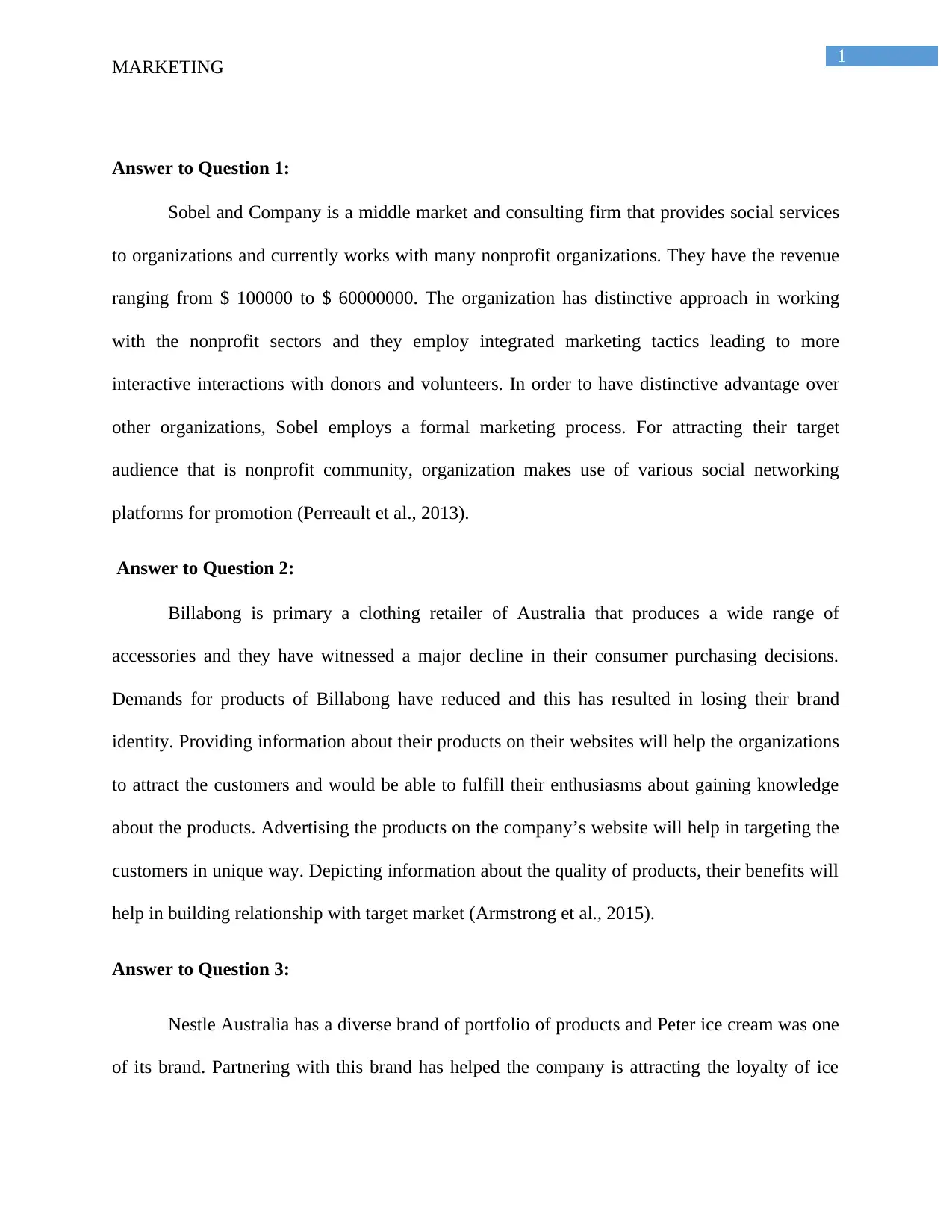
1
MARKETING
Answer to Question 1:
Sobel and Company is a middle market and consulting firm that provides social services
to organizations and currently works with many nonprofit organizations. They have the revenue
ranging from $ 100000 to $ 60000000. The organization has distinctive approach in working
with the nonprofit sectors and they employ integrated marketing tactics leading to more
interactive interactions with donors and volunteers. In order to have distinctive advantage over
other organizations, Sobel employs a formal marketing process. For attracting their target
audience that is nonprofit community, organization makes use of various social networking
platforms for promotion (Perreault et al., 2013).
Answer to Question 2:
Billabong is primary a clothing retailer of Australia that produces a wide range of
accessories and they have witnessed a major decline in their consumer purchasing decisions.
Demands for products of Billabong have reduced and this has resulted in losing their brand
identity. Providing information about their products on their websites will help the organizations
to attract the customers and would be able to fulfill their enthusiasms about gaining knowledge
about the products. Advertising the products on the company’s website will help in targeting the
customers in unique way. Depicting information about the quality of products, their benefits will
help in building relationship with target market (Armstrong et al., 2015).
Answer to Question 3:
Nestle Australia has a diverse brand of portfolio of products and Peter ice cream was one
of its brand. Partnering with this brand has helped the company is attracting the loyalty of ice
MARKETING
Answer to Question 1:
Sobel and Company is a middle market and consulting firm that provides social services
to organizations and currently works with many nonprofit organizations. They have the revenue
ranging from $ 100000 to $ 60000000. The organization has distinctive approach in working
with the nonprofit sectors and they employ integrated marketing tactics leading to more
interactive interactions with donors and volunteers. In order to have distinctive advantage over
other organizations, Sobel employs a formal marketing process. For attracting their target
audience that is nonprofit community, organization makes use of various social networking
platforms for promotion (Perreault et al., 2013).
Answer to Question 2:
Billabong is primary a clothing retailer of Australia that produces a wide range of
accessories and they have witnessed a major decline in their consumer purchasing decisions.
Demands for products of Billabong have reduced and this has resulted in losing their brand
identity. Providing information about their products on their websites will help the organizations
to attract the customers and would be able to fulfill their enthusiasms about gaining knowledge
about the products. Advertising the products on the company’s website will help in targeting the
customers in unique way. Depicting information about the quality of products, their benefits will
help in building relationship with target market (Armstrong et al., 2015).
Answer to Question 3:
Nestle Australia has a diverse brand of portfolio of products and Peter ice cream was one
of its brand. Partnering with this brand has helped the company is attracting the loyalty of ice
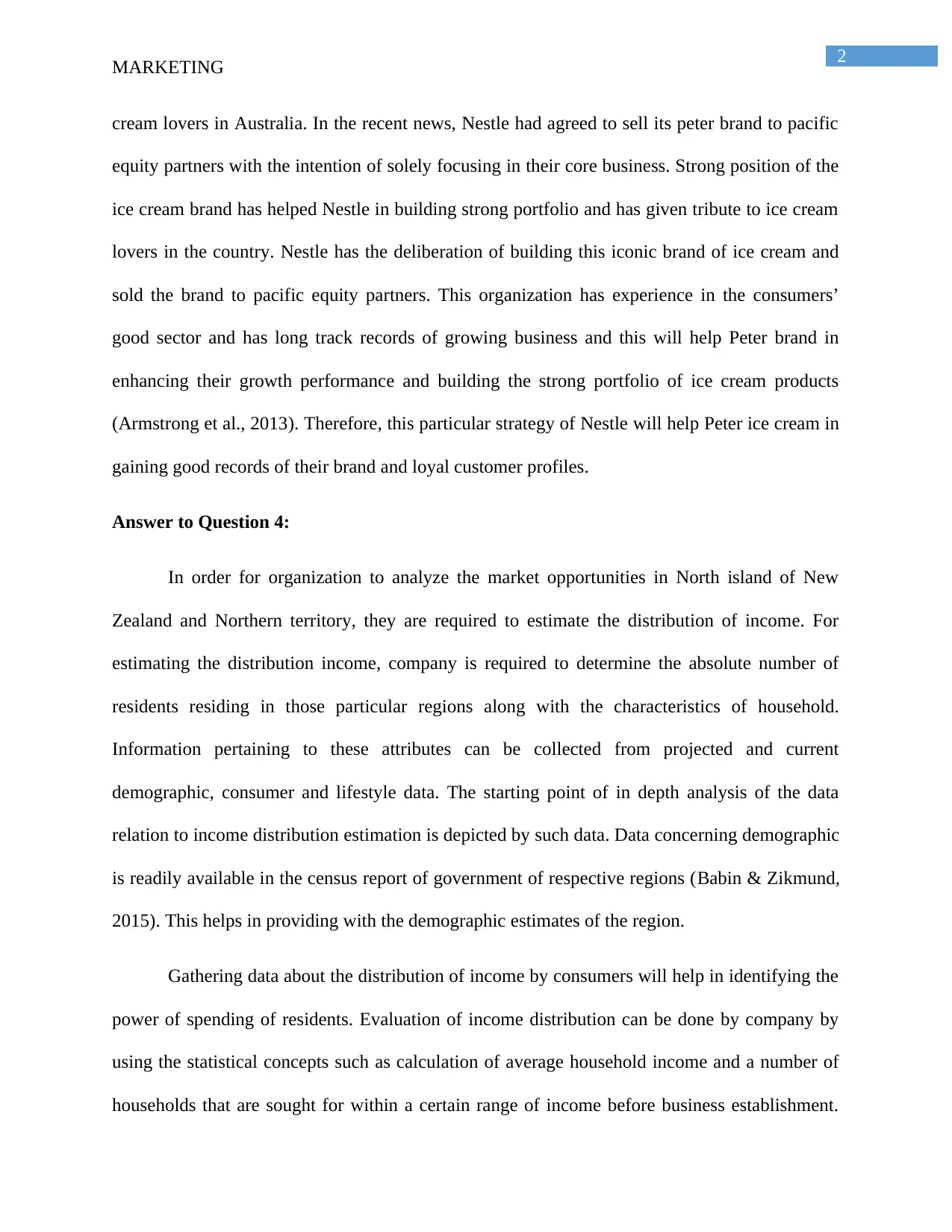
2
MARKETING
cream lovers in Australia. In the recent news, Nestle had agreed to sell its peter brand to pacific
equity partners with the intention of solely focusing in their core business. Strong position of the
ice cream brand has helped Nestle in building strong portfolio and has given tribute to ice cream
lovers in the country. Nestle has the deliberation of building this iconic brand of ice cream and
sold the brand to pacific equity partners. This organization has experience in the consumers’
good sector and has long track records of growing business and this will help Peter brand in
enhancing their growth performance and building the strong portfolio of ice cream products
(Armstrong et al., 2013). Therefore, this particular strategy of Nestle will help Peter ice cream in
gaining good records of their brand and loyal customer profiles.
Answer to Question 4:
In order for organization to analyze the market opportunities in North island of New
Zealand and Northern territory, they are required to estimate the distribution of income. For
estimating the distribution income, company is required to determine the absolute number of
residents residing in those particular regions along with the characteristics of household.
Information pertaining to these attributes can be collected from projected and current
demographic, consumer and lifestyle data. The starting point of in depth analysis of the data
relation to income distribution estimation is depicted by such data. Data concerning demographic
is readily available in the census report of government of respective regions (Babin & Zikmund,
2015). This helps in providing with the demographic estimates of the region.
Gathering data about the distribution of income by consumers will help in identifying the
power of spending of residents. Evaluation of income distribution can be done by company by
using the statistical concepts such as calculation of average household income and a number of
households that are sought for within a certain range of income before business establishment.
MARKETING
cream lovers in Australia. In the recent news, Nestle had agreed to sell its peter brand to pacific
equity partners with the intention of solely focusing in their core business. Strong position of the
ice cream brand has helped Nestle in building strong portfolio and has given tribute to ice cream
lovers in the country. Nestle has the deliberation of building this iconic brand of ice cream and
sold the brand to pacific equity partners. This organization has experience in the consumers’
good sector and has long track records of growing business and this will help Peter brand in
enhancing their growth performance and building the strong portfolio of ice cream products
(Armstrong et al., 2013). Therefore, this particular strategy of Nestle will help Peter ice cream in
gaining good records of their brand and loyal customer profiles.
Answer to Question 4:
In order for organization to analyze the market opportunities in North island of New
Zealand and Northern territory, they are required to estimate the distribution of income. For
estimating the distribution income, company is required to determine the absolute number of
residents residing in those particular regions along with the characteristics of household.
Information pertaining to these attributes can be collected from projected and current
demographic, consumer and lifestyle data. The starting point of in depth analysis of the data
relation to income distribution estimation is depicted by such data. Data concerning demographic
is readily available in the census report of government of respective regions (Babin & Zikmund,
2015). This helps in providing with the demographic estimates of the region.
Gathering data about the distribution of income by consumers will help in identifying the
power of spending of residents. Evaluation of income distribution can be done by company by
using the statistical concepts such as calculation of average household income and a number of
households that are sought for within a certain range of income before business establishment.
⊘ This is a preview!⊘
Do you want full access?
Subscribe today to unlock all pages.

Trusted by 1+ million students worldwide
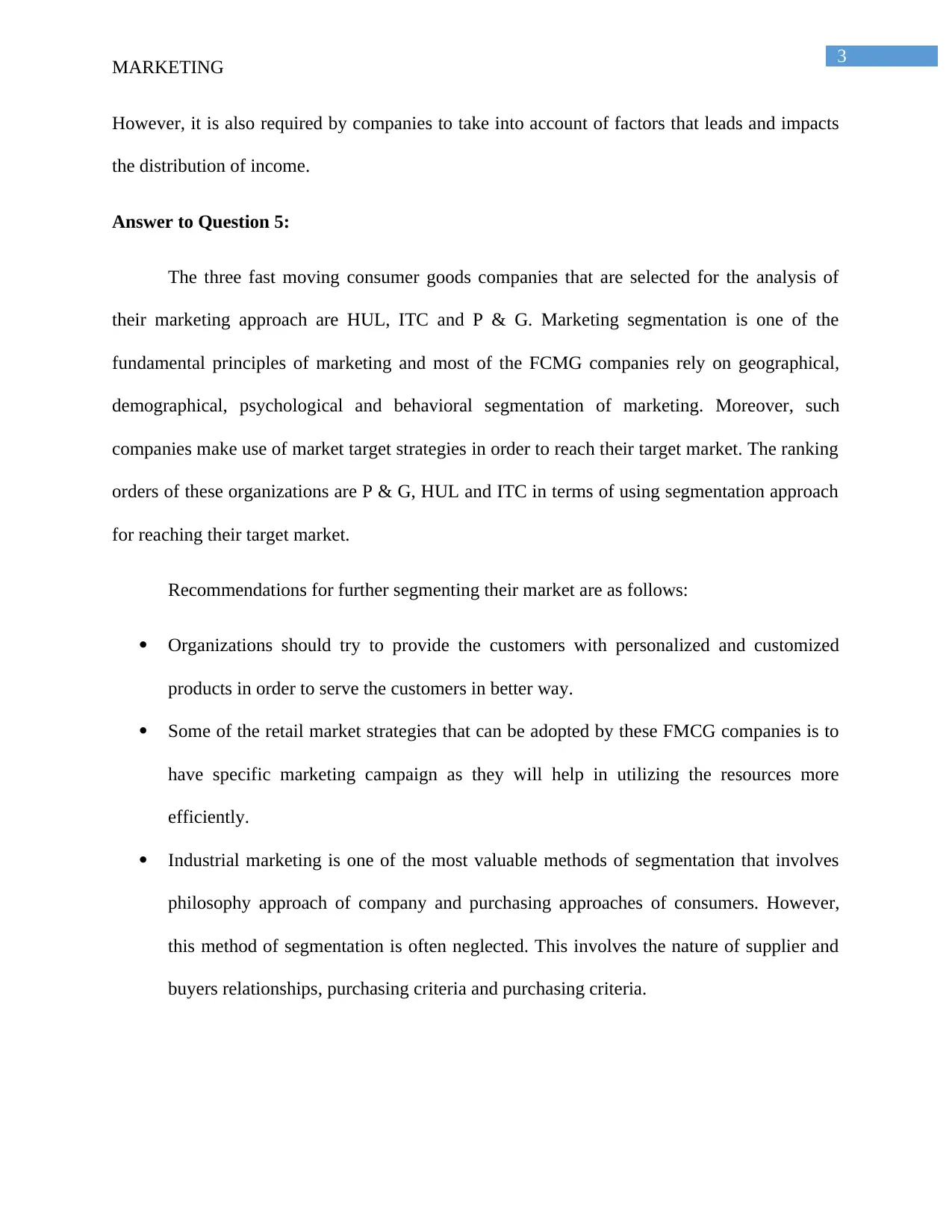
3
MARKETING
However, it is also required by companies to take into account of factors that leads and impacts
the distribution of income.
Answer to Question 5:
The three fast moving consumer goods companies that are selected for the analysis of
their marketing approach are HUL, ITC and P & G. Marketing segmentation is one of the
fundamental principles of marketing and most of the FCMG companies rely on geographical,
demographical, psychological and behavioral segmentation of marketing. Moreover, such
companies make use of market target strategies in order to reach their target market. The ranking
orders of these organizations are P & G, HUL and ITC in terms of using segmentation approach
for reaching their target market.
Recommendations for further segmenting their market are as follows:
Organizations should try to provide the customers with personalized and customized
products in order to serve the customers in better way.
Some of the retail market strategies that can be adopted by these FMCG companies is to
have specific marketing campaign as they will help in utilizing the resources more
efficiently.
Industrial marketing is one of the most valuable methods of segmentation that involves
philosophy approach of company and purchasing approaches of consumers. However,
this method of segmentation is often neglected. This involves the nature of supplier and
buyers relationships, purchasing criteria and purchasing criteria.
MARKETING
However, it is also required by companies to take into account of factors that leads and impacts
the distribution of income.
Answer to Question 5:
The three fast moving consumer goods companies that are selected for the analysis of
their marketing approach are HUL, ITC and P & G. Marketing segmentation is one of the
fundamental principles of marketing and most of the FCMG companies rely on geographical,
demographical, psychological and behavioral segmentation of marketing. Moreover, such
companies make use of market target strategies in order to reach their target market. The ranking
orders of these organizations are P & G, HUL and ITC in terms of using segmentation approach
for reaching their target market.
Recommendations for further segmenting their market are as follows:
Organizations should try to provide the customers with personalized and customized
products in order to serve the customers in better way.
Some of the retail market strategies that can be adopted by these FMCG companies is to
have specific marketing campaign as they will help in utilizing the resources more
efficiently.
Industrial marketing is one of the most valuable methods of segmentation that involves
philosophy approach of company and purchasing approaches of consumers. However,
this method of segmentation is often neglected. This involves the nature of supplier and
buyers relationships, purchasing criteria and purchasing criteria.
Paraphrase This Document
Need a fresh take? Get an instant paraphrase of this document with our AI Paraphraser
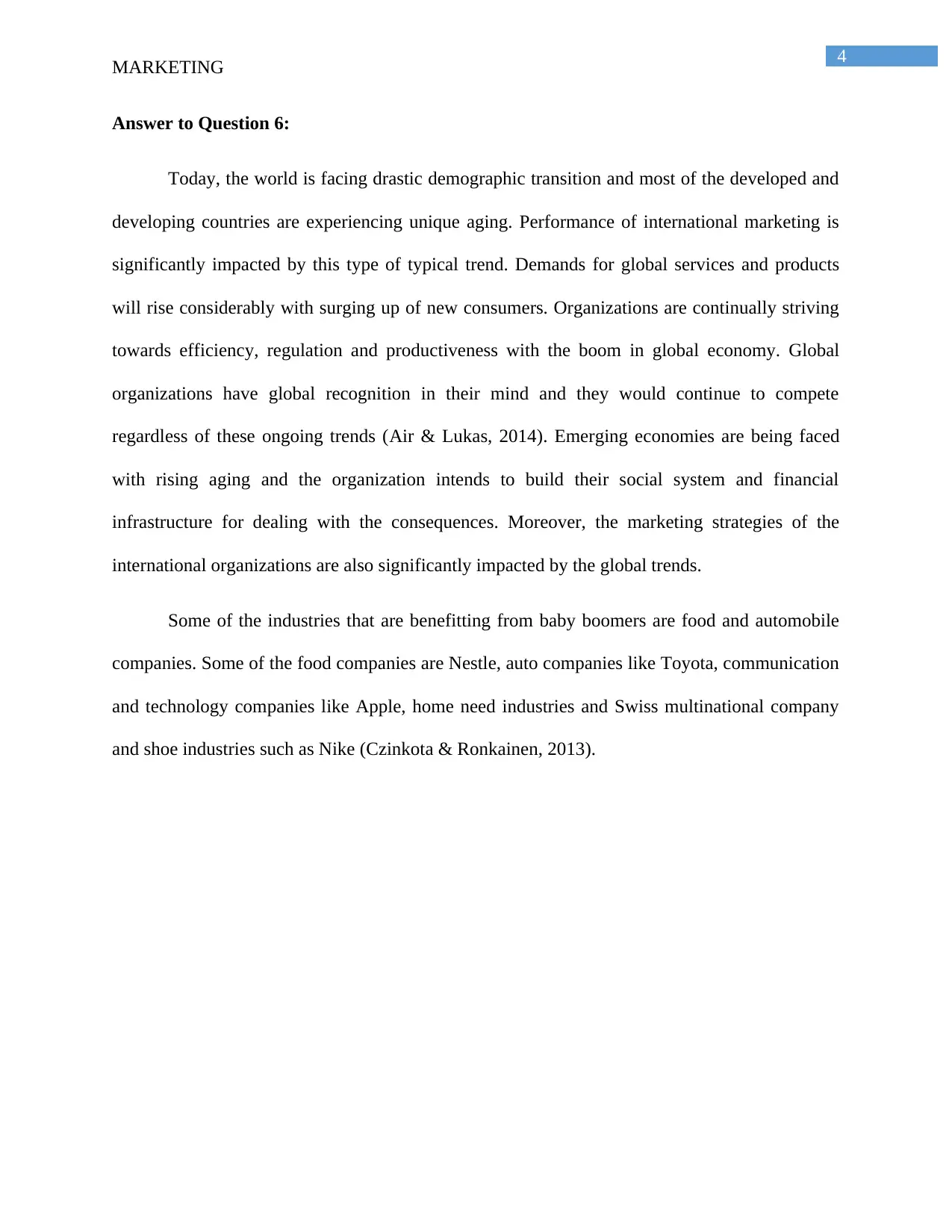
4
MARKETING
Answer to Question 6:
Today, the world is facing drastic demographic transition and most of the developed and
developing countries are experiencing unique aging. Performance of international marketing is
significantly impacted by this type of typical trend. Demands for global services and products
will rise considerably with surging up of new consumers. Organizations are continually striving
towards efficiency, regulation and productiveness with the boom in global economy. Global
organizations have global recognition in their mind and they would continue to compete
regardless of these ongoing trends (Air & Lukas, 2014). Emerging economies are being faced
with rising aging and the organization intends to build their social system and financial
infrastructure for dealing with the consequences. Moreover, the marketing strategies of the
international organizations are also significantly impacted by the global trends.
Some of the industries that are benefitting from baby boomers are food and automobile
companies. Some of the food companies are Nestle, auto companies like Toyota, communication
and technology companies like Apple, home need industries and Swiss multinational company
and shoe industries such as Nike (Czinkota & Ronkainen, 2013).
MARKETING
Answer to Question 6:
Today, the world is facing drastic demographic transition and most of the developed and
developing countries are experiencing unique aging. Performance of international marketing is
significantly impacted by this type of typical trend. Demands for global services and products
will rise considerably with surging up of new consumers. Organizations are continually striving
towards efficiency, regulation and productiveness with the boom in global economy. Global
organizations have global recognition in their mind and they would continue to compete
regardless of these ongoing trends (Air & Lukas, 2014). Emerging economies are being faced
with rising aging and the organization intends to build their social system and financial
infrastructure for dealing with the consequences. Moreover, the marketing strategies of the
international organizations are also significantly impacted by the global trends.
Some of the industries that are benefitting from baby boomers are food and automobile
companies. Some of the food companies are Nestle, auto companies like Toyota, communication
and technology companies like Apple, home need industries and Swiss multinational company
and shoe industries such as Nike (Czinkota & Ronkainen, 2013).
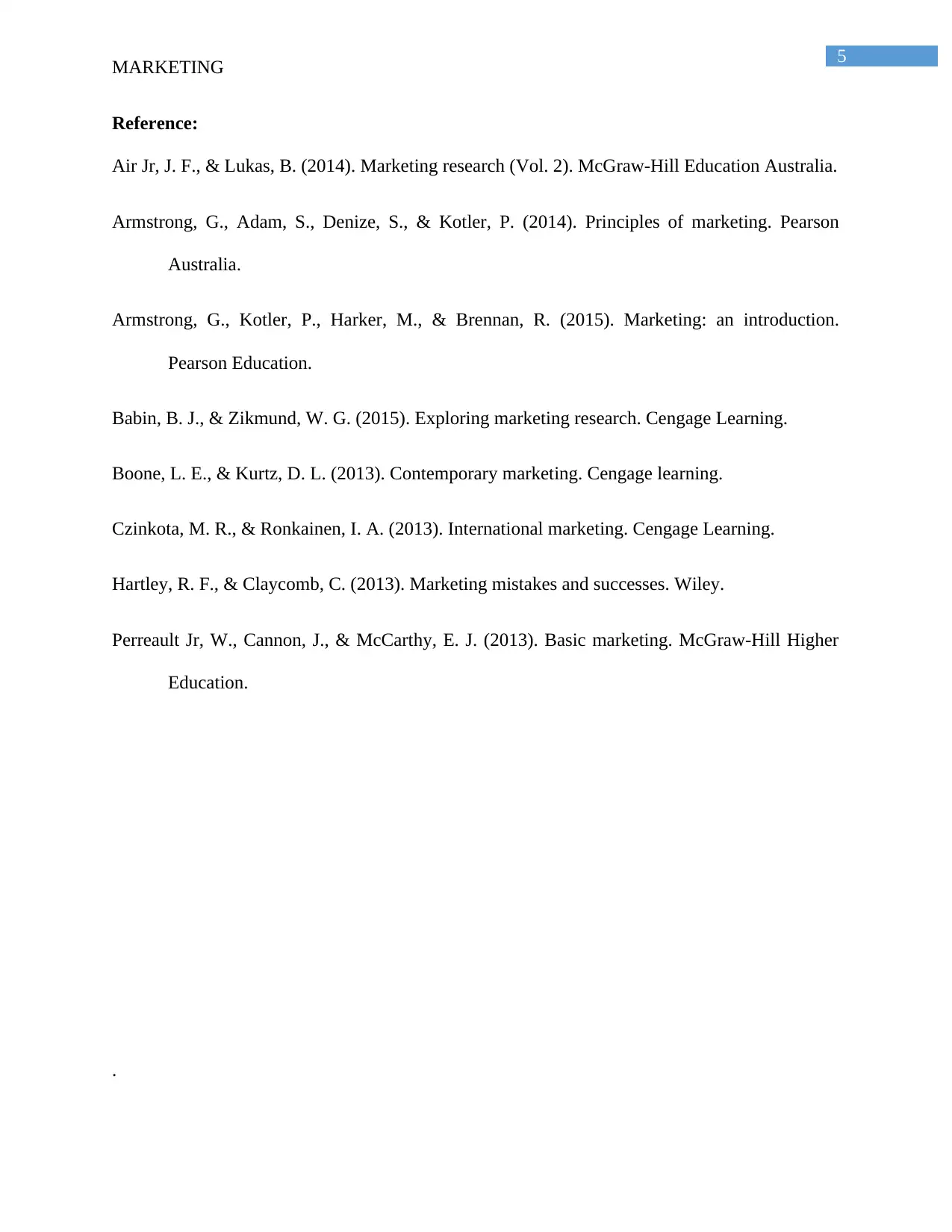
5
MARKETING
Reference:
Air Jr, J. F., & Lukas, B. (2014). Marketing research (Vol. 2). McGraw-Hill Education Australia.
Armstrong, G., Adam, S., Denize, S., & Kotler, P. (2014). Principles of marketing. Pearson
Australia.
Armstrong, G., Kotler, P., Harker, M., & Brennan, R. (2015). Marketing: an introduction.
Pearson Education.
Babin, B. J., & Zikmund, W. G. (2015). Exploring marketing research. Cengage Learning.
Boone, L. E., & Kurtz, D. L. (2013). Contemporary marketing. Cengage learning.
Czinkota, M. R., & Ronkainen, I. A. (2013). International marketing. Cengage Learning.
Hartley, R. F., & Claycomb, C. (2013). Marketing mistakes and successes. Wiley.
Perreault Jr, W., Cannon, J., & McCarthy, E. J. (2013). Basic marketing. McGraw-Hill Higher
Education.
.
MARKETING
Reference:
Air Jr, J. F., & Lukas, B. (2014). Marketing research (Vol. 2). McGraw-Hill Education Australia.
Armstrong, G., Adam, S., Denize, S., & Kotler, P. (2014). Principles of marketing. Pearson
Australia.
Armstrong, G., Kotler, P., Harker, M., & Brennan, R. (2015). Marketing: an introduction.
Pearson Education.
Babin, B. J., & Zikmund, W. G. (2015). Exploring marketing research. Cengage Learning.
Boone, L. E., & Kurtz, D. L. (2013). Contemporary marketing. Cengage learning.
Czinkota, M. R., & Ronkainen, I. A. (2013). International marketing. Cengage Learning.
Hartley, R. F., & Claycomb, C. (2013). Marketing mistakes and successes. Wiley.
Perreault Jr, W., Cannon, J., & McCarthy, E. J. (2013). Basic marketing. McGraw-Hill Higher
Education.
.
⊘ This is a preview!⊘
Do you want full access?
Subscribe today to unlock all pages.

Trusted by 1+ million students worldwide

6
MARKETING
MARKETING
1 out of 7
Related Documents
Your All-in-One AI-Powered Toolkit for Academic Success.
+13062052269
info@desklib.com
Available 24*7 on WhatsApp / Email
![[object Object]](/_next/static/media/star-bottom.7253800d.svg)
Unlock your academic potential
Copyright © 2020–2025 A2Z Services. All Rights Reserved. Developed and managed by ZUCOL.




